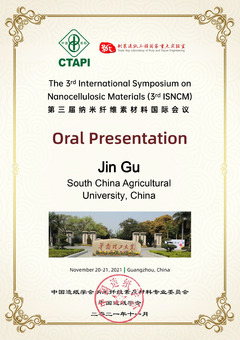Cellulose nanofibrils as reducing and stabilizing agents in the synthesis of noble metal nanoparticles and their applications in catalysts and sensors
ID:13
Submission ID:46 View Protection:PRIVATE
Updated Time:2021-10-29 10:33:49 Hits:956
Oral Presentation
Abstract
Synthesis of noble metal nanoparticles has attracted considerable interests due to their versatile roles in catalysts, sensors and other applications. However, to obtain monodisperse and stable metal nanoparticles, the use of capping agent, reducing agent, and/or reaction solvent are typically required, which possibly involve the utilization of toxic chemicals. In this study, a reagentless method was reported for synthesizing palladium and silver nanoparticles supported on TEMPO oxidized cellulose nanofibrils (CNFs). CNFs played a multiple role as a supporting matrix, capping and reducing agent. Stable noble metal NPs were successfully obtained by simply mixing the CNFs with metal precursor solutions and heating the aqueous mixtures to 80-90 C for 0.5-2 h. The as synthesized metal NPs were tightly associated with CNFs. We further demonstrate the applications of CNF/noble metal NPs hybrids in three aspects: 1) CNFs decorated with palladium nanoparticles (PdNPs) are able to self-assemble to aerogels by a freeze-drying process and could be used for catalytic discoloration of methylene blue and Congo red; 2) CNF decorated with silver nanoparticles (AgNPs) formed stable colloidal suspension and showed sensitive, rapid and selective colorimetric detection of L-Cystein; 3) Sphere-like AgNPs formed on the CNF surface could be further transformed into faceted AgNP when reacting with a etching agent. CNF played an additional role of shape-regulating agent. CNF hybridized with faceted AgNPs exhibited surface enhanced Raman scattering performance for sensitive detection of methylene blue. These examples illustrate CNF hybridized with noble metal NPs have been successfully synthesized via a green route and have great potentials for practical catalytic applications and optical sensors.
Keywords
cellulose nanofibrils,palladium nanoparticles,sensors,Catalysis,silver nanoparticles
Submission Author
Jin Gu
South China Agricultural University
Anthony Dichiara
University of Washington
Chuanshuang Hu
South China Agricultural University



Comment submit